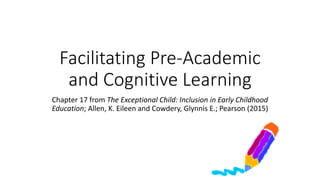
Chapter 17 facilitating pre-academic and cognitive learning
- 1. Facilitating Pre-Academic and Cognitive Learning Chapter 17 from The Exceptional Child: Inclusion in Early Childhood Education; Allen, K. Eileen and Cowdery, Glynnis E.; Pearson (2015)
- 2. Focus • In this chapter, we will identify strategies for adapting the learning environment to meet the pre-academic needs of all children, including those with exceptionalities
- 3. What’s Your Philosophy? •Pre-academics? •Academics? •Emerging Literacy? • Are those words that strike fear in your Early Childhood heart?
- 4. What Do We Really Mean? • How can we help children develop the foundational skills that they will need to be successful academically? • How can we avoid inappropriate watered down academic curricula and paper-and-pencil worksheets?
- 5. How Times Have Changed! • The concept of pre-academics was once shunned by early childhood educators and teachers of exceptional children. • Pre-academics are now considered part of holistic development (integration of activities that support development in all domains) that all help a child’s cognitive development. • More terms • Preoperational • Readiness • Even if children’s work is “playing”, teachers must be intentional in providing developmentally appropriate experiences (p. 444) that help children maximize their learning and development.
- 6. Brain Development • The brain is very active in the first years of life • Synapses (neural pathways) are connecting at incredible rates • Healthy brain development reinforces those synapses • Responsive caregiving • Positive experiences, especially through critical learning periods • Intentional, intensive, and developmentally appropriate interventions as needed • Negative brain development may occur from • Non-responsive or poor caregiving • Stressors and at risk early years such as violence, poverty, etc. • Lack of stimulation • Note the “brain research” box at the bottom of p. 445 in your text.
- 7. Getting the Right Balance • Children from low income and academically deprived families especially benefit from a combination of integrated play and teacher directed activities • Learning experiences must be developmentally appropriate – worksheets, memorization, and drill and practice with flashcards are not considered developmentally appropriate! • What about children with disabilities? • Intentional, developmentally appropriate play and teacher directed activities can help minimize the potential for secondary disabilities • Careful observation and assessment helps the teacher plan activities that meet the child where she is and develop step by step
- 8. Appropriate Strategies • Direct teaching • May be combined with indirect teaching • Teacher takes more of a facilitator role • Embedded learning • Child has additional opportunities to practice skills and new learning • Activities are expanded and modified to integrate additional learning practice • Teacher builds on child’s interests and motivation • IEP goals and objectives are clarified • Observations, data collection, and assessments are systematic and used for both planning and recording of skills needed and attained
- 9. Appropriate Strategies (cont.) • Computers and other assistive technology • Support autonomy • Support communication • Activities must be carefully planned, developmentally appropriate, and not keeping children from interacting physically and socially • Keep children motivated • Encourage their interests, questioning, and discovery • Involve sensory experiences • Use your own academic skills to model for children • Write their questions and help them explore for answers • Advocate for embedded pre-academics with parents, administrators, and others who may be pushing for inappropriate academic experiences
- 10. NAEYC Connection • Compare NAEYC Ecada Key Element 1c: Using developmental knowledge to create healthy, respectful, supportive, and challenging learning environments to • “Valuing Today’s Learning” on p. 452 in your text Our abilities to create positive environments for children is what high quality childcare is all about. We need to be excited, intentional in our knowledge and planning, and use the environment as a “third teacher”. Children who have the type environment described above do not have behavior problems. They are busy and engaged in their learning!
- 11. Developing Readiness Skills • Both experiences and knowledge contribute to readiness skills • Readiness-as-maturation theory attributes learning to natural step-by- step progression. • Because experiences (learning theory) are now considered part of the developmental process, teachers must not make the mistake of “waiting for a child to mature” before integrating developmentally appropriate experiences. • This is especially important for children with delays or exceptionalities. • Learning theory emphasizes task analysis (step-by-step, sequencing) as appropriate for teaching skills to children with exceptionalities.
- 12. Developing Readiness Skills (cont.) • Some specific readiness skills that are likely to be missing for children with exceptionalities are listed on p. 453 • These are further described in your text with excellent strategies, activities, and task analysis information found through p. 464. • The text suggests using the checklist “Taking Stock of what you do to promote literacy” to help ensure a literacy rich environment. • Additional tips for planning and presenting pre-academic skills are further described on pp. 465-468 • All of this takes careful planning but is essential for an inclusive classroom.
- 13. References • Allen, K. E., & Cowdery, G. E. (2015). The Exceptional Child: Inclusion in Early Childhood Education. (8th Edition). Cengage Learning. Stamford, CT. • National Association for the Education of Young Children. (2011). 2010 Standards for Initial Early Childhood Professional Preparation. Retrieved from http://www.naeyc.org/ncate/files/ncate/Initial_2pager.pdf • National Association for the Education of Young Children. (2003). Taking Stock of what you do to promote literacy. Retrieved from http://www.naeyc.org/files/yc/file/200303/PromotingLiteracy.pdf